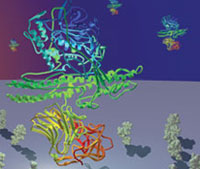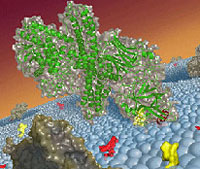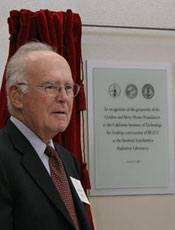


Contents of this Issue:
1. Science Highlight —
Taming a Potent Toxin
(contacts: Q. Chai, qingchai@scripps.edu and R. Stevens,
stevens@scripps.edu, TSRI;
R. Jin, rsjin@slac.stanford.edu and A. Brunger,
axel.brunger@stanford.edu, Stanford University)
Botulinum neurotoxin is produced by the bacteria Clostridium botulinum and is the most potent toxin known, inducing a potentially fatal paralysis known as "botulism." Botulism can occur in a number of ways, including infection through open wounds or in the intestinal tract, or after consuming contaminated food in which toxin has been produced. In the USA, infant botulism is the most common manifestation of the disease-some speculate whether its prevalence is linked to sudden infant death syndrome. On the other hand, these neurotoxins have also become a powerful therapeutic tool for treating a variety of neurological, ophthalmic, and other disorders manifested by abnormal, excessive, or inappropriate muscle contractions.
In a recent series of x-ray crystallography studies conducted in part at SSRL, two research groups have determined the mechanism by which the botulinum neurotoxin binds to nerve receptors and causes infection, which could lead to new preventive and therapeutic treatments. The work is published in the December 13, 2006, issue of Nature.
Recently, researchers from a collaboration led by The Scripps Research Institute completed studies on the structures of botulinum toxin in complex with a neuronal cell surface receptor and botulinum toxin with two different neutralizing antibodies, each to a resolution of 2.6 Å. The group also performed biochemical, mutagenesis, and neurobiology experiments to complement the structural work. The interdisciplinary research projects provide insight into the atomic details on the intoxication process, and the means by which antibodies neutralize the effects. These structures open the possibility of developing improved broad-spectrum therapeutics, including antibodies, small molecule drugs and vaccines against the toxin.
In an adjoining study published in the same issue of Nature, Axel Brunger's group at Stanford University determined the first crystal structure of a botulinum neurotoxin in complex with its protein receptor to a resolution of 2.15 Å. The results could lead to development of preventive vaccines or inhibitors against these neurotoxins. Additionally, owing to the specific geometry of the binding mechanism, this study suggests that appropriately modified botulinum neurotoxins could also be used as drug delivery systems.
To learn more about this research see the Stevens and Brunger scientific
highlights at:
http://www-ssrl.slac.stanford.edu/research/highlights_archive/BoNT-stevens.html
and
http://www-ssrl.slac.stanford.edu/research/highlights_archive/BoNT-brunger.html
2. Science Highlight —
Ancient Warriors and the Origin of Chinese Purple
(contact:
Z. Liu, zhiliu@stanford.edu)
 | |
| Samples of a pigment called Chinese purple were obtained from this kneeling archer, one of 8,000 terra cotta warriors discovered in 1974. | |
To test this hypothesis, SSRL researchers Zhi Liu, Apurva Mehta and colleagues from Stanford University, the Advanced Light Source and China used a series of synchrotron-based x-ray techniques, in particular micro-x-ray diffraction and micro-x-ray fluorescence, to characterize the exact chemical make-up of the pigments in Chinese purple. Liu found that deep within the structure of Egyptian blue, calcium plays a key role in the pigment's molecular identity, whereas in Chinese purple, that same slot is filled by the element barium. Liu concluded that, based on this difference, and despite the two pigments' structural similarity, Chinese artisans invented Chinese purple independently of Egyptian influence.
"Stable purple is rare in nature," Liu said. "People already knew what the pigment was, but by making a chemical map and combining it with archeological evidence, we were able to solve the puzzle of where it came from."
Scholars believe that Chinese alchemists 2,200 years ago were most interested in synthesizing jade, a mineral regarded as sacred in Taoist culture. Liu's analysis found that, based on the combination of compounds used to make the pigment and the technologies available to Chinese artisans at the time, Chinese purple was most likely first developed by Taoist glassmakers attempting to create artificial jade.
To learn more about this research see the full scientific highlight at:
http://www-ssrl.slac.stanford.edu/research/highlights_archive/chinesepurple.html
3. Stanford-Caltech Collaboration Creates New
X-ray "Molecular Observatory"
(contact:
K.O. Hodgson, hodgson@ssrl.slac.stanford.edu)
 | |
| Gordon Moore, just after unveiling a plaque at the newly dedicated Molecular Observatory for Structural Molecular Biology at Beam Line 12. (Photo courtesy of Diana Rogers.) |
4.
Rapid Access Beam Time for SMB XAS BL7-3
 |
5. SSRL School on Hard X-ray
Scattering: Techniques in Materials and Environmental Sciences - May 15-17
(contact:
John Bargar, Bargar@slac.stanford.edu)
Overview: Modern synchrotron-based X-ray scattering (SR-XRS) techniques offer the ability to probe nano- and atomic-scale structures and order/disorder relationships that critically govern the properties of advanced technological and environmental materials. The high collimation, intensity, and tunability of SR allow the investigation of a wide range of materials, including thin films and interfaces, nanoparticles, amorphous materials, solutions, hydrated and disordered bacteriogenic minerals, soils, and highly crystalline materials.
Good planning and a working knowledge of beam lines, in addition to techniques, are keys to conducting successful SR-XRS measurements. This school will provide a practical users' guide to planning and conducting scattering measurements at SSRL beam lines. Important techniques, including surface and thin-film scattering, powder diffraction, in-situ x-ray scattering, and amorphous materials will be covered. In all cases, we will cover topics that are not commonly addressed in text books or class lectures, but are typically obtained only through on-the-experiment training. The first day of the school (May 15), will be a lecture day.
The school includes two days of hands-on training at SSRL hard x-ray scattering
beam lines (May 16 and 17; registration limited to 20 participants). Costs will
be $25 for graduate students and $50 for all others. Register at:
http://www-ssrl.slac.stanford.edu/conferences/workshops/scatter2007/reg.php
6.
2007 Ultrafast Summer School - June 18-22
(Summer School
Chairs: N. Berrah, Western Michigan University; P. Bucksbaum,
Stanford University/SLAC)
 |
|
|
| |
The goal of the School is to disseminate information about scientific
opportunities in ultrafast science and train students and post docs on the new
FEL facilities as well as inform researchers who are interested to join this
exciting new field. Lectures will be presented by expert scientists in the
various aforementioned fields. The attendees will be expected to participate in
the discussions since we plan to offer these lectures in an interactive style
mode to make it effective and interesting to the audience. For program
information and to register see:
http://photonscience.slac.stanford.edu/pulse/uxss2007/index.php
7.
SMB XAS Short Course Wrap-Up
 |
|
8.
SSRL Users, Affiliates and Faculty Honored
 |
 |
9. Upcoming Beam Time Proposal Deadlines
The deadline for new X-ray/VUV proposals is May 1, 2007 for beam time eligibility beginning fall 2007.
July 1, 2007 is the next deadline for submitting macromolecular crystallography proposals. For beam time before fall 2007 please submit a Rapid Access proposal.
For more information about submitting a proposal for beam time at SSRL see:
http://www-ssrl.slac.stanford.edu/users/user_admin/guide.html
10.
Photon Science Job Opportunities
__________________________________________________________________________
SSRL Headlines is published electronically monthly to inform SSRL users, sponsors and other interested people about happenings at SSRL. SSRL is a national synchrotron user facility operated by Stanford University for the U.S. Department of Energy Office of Basic Energy Sciences. Additional support for the structural biology program is provided by the DOE Office of Biological and Environmental Research, the NIH National Center for Research Resources and the NIH Institute for General Medical Sciences. Additional information about SSRL and its operation and schedules is available from the SSRL WWW site.
__________________________________________________________________________
To leave the SSRL-HEADLINES distribution, send email as shown below:
To: LISTSERV@SSRL.SLAC.STANFORD.EDU Subject: (blank, or anything you like)
The message body should read
SIGNOFF SSRL-HEADLINES
That's all it takes. (If we have an old email address for you that is forwarded to your current address, the system may not recognize who should be unsubscribed. In that case please write to ssrl-headlines-request@ssrl.slac.stanford.edu and we'll try to figure out who you are so that you can be unsubscribed.)
If a colleague would like to subscribe to the list, he or she should send To: LISTSERV@SSRL.SLAC.STANFORD.EDU and use the message body
SUBSCRIBE SSRL-HEADLINES
|
SSRL Welcome
Page | Research
Highlights | Beam Lines | Accel
Physics
User Admin | News & Events | Safety Office |